Occupy Cincinnati - Beginnings
On October 8, 2011, discontented Cincinnatians joined a growing movement that at the time was just beginning to sweep the nation. Occupy Wall Street (OWS) was becoming "Occupy Everywhere" as Americans claiming to be fed up with corporate abuse of our political system took to the streets to occupy public spaces and protest about everything from war and the economy to education and the environment . With the battle cry of "We are the 99%", this new movement set out to draw attention to the social and economic inequalities of our system, making reference to the fact that the vast majority of wealth in our country is actually held by only 1% of the population and that the rift between the very rich and the very poor is rapidly growing while a once strong middle class quickly disappears.
The movement at first received little mainstream press. It almost seemed that it was being systematically ignored, but that became impossible as Occupy grew and authorities responded with harsher measures. As videos of strong-arm police tactics went viral on the internet the stories became harder for the established press to overlook. Seemingly peaceful protesters being pepper sprayed or thrown to the ground and beaten began to appear over and over again in the news. Many police departments across the country adopted a militarized approach to dealing with the movement, turning some occupation actions into scenes that more resembled war zones than the peaceful protests they were intended to be. A battle for the hearts and minds of Americans ensued.
I began photographing the movement in Cincinnati even before the first protest, attending early planning meetings to get an idea of the what, wheres and whens of the actions to come. Since the late 1980s protest movements have been an ongoing project of mine and I have used the main title of this project as a working title for the entire body of this work. With my Occupy project I have hoped to put a face on this particular movement and approach the question, "Who are the 99%?". Some have claimed them to be nothing more than a gang of lazy, whiny, unemployed socialists looking for handouts, but I discovered that the variety of backgrounds found among the protesters was far too vast to generalize. Frankly, while I have certainly encountered a few Socialists along the way, as well as a few lay-abouts looking for a handout, they seem to come from every conceivable political background, age group, economic standing and cultural grouping. Many are working two or even three jobs to make ends meet and the dedication to their cause and the willingness to risk arrest (or worse) to meet their goals seems to disqualify "lazy" and "whiny" as appropriate adjectives.
One thing that sets Occupy Cincinnati apart from some of the other occupations across the country has been the level of cooperation between protesters and police here. A strong liaison was put in place even before the very first protest. As a result there has not been the same use of aggressive police response; no pepper spray, tear gas or flash grenades were employed here as we have seen in other cities. The choice was made by police early on not to use riot gear to intimidate protesters and we have not seen the violent arrests and unnecessary force that became a common state of affairs in occupations such as N.Y.C., Oakland, Seattle, Boston and Washington. So you will not see that kind of drama in this gallery of images. What you hopefully will see is a portrait of a movement in its infancy. You will see how citations led to arrests, how civil disobedience led to City Hall and then to City Court and how standing your ground and fighting through the system as well as outside it can sometimes lead to real and positive gains. While I have chosen this point to end a chapter in all probability it is only just the beginning of a much longer story.
The movement at first received little mainstream press. It almost seemed that it was being systematically ignored, but that became impossible as Occupy grew and authorities responded with harsher measures. As videos of strong-arm police tactics went viral on the internet the stories became harder for the established press to overlook. Seemingly peaceful protesters being pepper sprayed or thrown to the ground and beaten began to appear over and over again in the news. Many police departments across the country adopted a militarized approach to dealing with the movement, turning some occupation actions into scenes that more resembled war zones than the peaceful protests they were intended to be. A battle for the hearts and minds of Americans ensued.
I began photographing the movement in Cincinnati even before the first protest, attending early planning meetings to get an idea of the what, wheres and whens of the actions to come. Since the late 1980s protest movements have been an ongoing project of mine and I have used the main title of this project as a working title for the entire body of this work. With my Occupy project I have hoped to put a face on this particular movement and approach the question, "Who are the 99%?". Some have claimed them to be nothing more than a gang of lazy, whiny, unemployed socialists looking for handouts, but I discovered that the variety of backgrounds found among the protesters was far too vast to generalize. Frankly, while I have certainly encountered a few Socialists along the way, as well as a few lay-abouts looking for a handout, they seem to come from every conceivable political background, age group, economic standing and cultural grouping. Many are working two or even three jobs to make ends meet and the dedication to their cause and the willingness to risk arrest (or worse) to meet their goals seems to disqualify "lazy" and "whiny" as appropriate adjectives.
One thing that sets Occupy Cincinnati apart from some of the other occupations across the country has been the level of cooperation between protesters and police here. A strong liaison was put in place even before the very first protest. As a result there has not been the same use of aggressive police response; no pepper spray, tear gas or flash grenades were employed here as we have seen in other cities. The choice was made by police early on not to use riot gear to intimidate protesters and we have not seen the violent arrests and unnecessary force that became a common state of affairs in occupations such as N.Y.C., Oakland, Seattle, Boston and Washington. So you will not see that kind of drama in this gallery of images. What you hopefully will see is a portrait of a movement in its infancy. You will see how citations led to arrests, how civil disobedience led to City Hall and then to City Court and how standing your ground and fighting through the system as well as outside it can sometimes lead to real and positive gains. While I have chosen this point to end a chapter in all probability it is only just the beginning of a much longer story.

A protester wears a Guy Fawkes mask next to the statue of Lincoln in Lytle Park where the very first march for Occupy Cincinnati began. Guy Fawkes has become the "poster boy" for the movement because of his use in the film V for Vendetta.

Drummers warm up the crowd at Lytle Park.

Capt. Dan Gerard watches the protesters gather in Lytle Park on October 8, 2011.
"We've been watching the videos from New York", he said, in reference to violent arrests and the use of pepper spray, "We don't want anything like that to happen here".
"We've been watching the videos from New York", he said, in reference to violent arrests and the use of pepper spray, "We don't want anything like that to happen here".

Josh Spring, who is also the director of the Cincinnati Coalition for the Homeless, rallies the crowd for the march on October 8, 2011.

Protesters prepare for the first Occupy Cincinnati march in Lytle Park.

A young girl finds shade in the shadow of the statue of Lincoln in Lytle Park before the start of the October 8th march.

More than 1000 protesters take to the streets of Cincinnati for the October 8th march.

The march made its way through the economically depressed Over-the-Rhine section of the city where boarded-up stores are a common sight.

A resident spectator to the march seemed somewhat bemused by the long line of protesters walking the sidewalks through Over-the-Rhine.

Fountain Square was the destination of the march and became the first temporary occupation location when the group's permit ran out at midnight. Justin Jeffre and Robert Pace keep the chants going with megaphones.

A young boy sits engaged with the speakers at Occupy Cincinnati's first General Assembly on Fountain Square.

People on Fountain Square engage in direct democracy at the General Assembly.

Police stood vigilant on the periphery, not really knowing what to expect from the protesters. They had remained pretty hands-off throughout the days events, but as the clock moved towards park closure and civil disobedience uncertainty could be felt on all sides.

Protester on Fountain Square.

Occupy lawyer Geoffrey Miller speaks with protesters who plan to remain on the Square after closure and risk arrest.

Robert Pace takes some time to meditate on his decision to risk arrest through civil disobedience. The police gave the protesters until 3am to leave the Square.

When the bars on the Square closed at 2am a inebriated patron confronted Les Courtney (L) about his politics. Police quickly diffused the situation.

Police move in to give protesters a last chance to leave the Square and avoid arrest. Ten remain behind.

Nine of the ten remaining protesters form a sit-in as everyone else is cleared off the Square.

Police officers stand ready with plastic handcuffs to arrest protesters who remain on the Square.

In the end police just held the remaining protesters on the Square until 6am and then released them. The following day a more long-term occupation began at nearby Piatt Park.

On October 9, 2011, the occupation of Piatt Park began. The historical context of the park was not lost on the protesters, being the very first public park in Cincinnati, "Donated to the People", as the sign states, in 1817.

A General Assembly is held in Piatt Park on October 11th. General Assemblies were a daily experience during the occupation where direct democracy and consensus voting was in play in order to make decisions about future actions and day-to-day operation of the occupation site.

The General Assembly in full swing, with facilitators, watchers and a secretary in place to allow the processes to run smoothly and decisions to be properly recorded.

This is a high-tech revolution and the computer is a key tool in the fight. Makayla Lane looks over Chelsea Sprang's shoulder as she networks for Occupy.

Occupy is certainly a melting pot of different people and cultures drawn together for a common cause. Tynisa Compton introduces herself to Gonzo Robe.

Jonah Halvorson, Johnail Jewell and Les Courtney wear their citations from the previous night pinned to their chests like badges of honor.

Erik Crew makes a point in one of the many committee meetings taking place in the park. Ideas are formed in committee to be brought to the larger group in General Assemby.

Dan Denkijin uses his laptop camera to livestream the Cincinnati Occupation on the internet. Livestreaming is a common practice of the various occupations around the country, allowing anyone to see what is happening in real-time and also communicate with occupation members.

Les Courtney in Piatt Park October 10, 2011. Les was one of the original 10 who risked arrest that first night on Fountain Square and has accumulated multiple citations for defying the curfew in Piatt Park. “To be cited is me voicing my opinion that I am here and what they are doing is wrong,” he says.

Razzle texts a message from the Occupation.

David Schraffenberger is illuminated by the light of his laptop during a General Assembly meeting.

A supporter stands on the sidewalk as protesters are ticketed in the park for breaking curfew.

Dan La Botz sits by the statue of Garfield in Piatt Park October 11, 2011. Dan has been a professor of History and Latin American Studies at various universities in the Cincinnati area for some time and ran as a candidate for the U.S. Senate on the Ohio Socialist Party ticket in 2010.

Though the Cincinnati Parks Board denied a permit for the occupation of Piatt Park earlier that day, Director of Parks Willie Carden came down that evening to observe and listen to the general assembly.

Occupy Cincinnati goes into its fourth night in Piatt Park after the initial night on Fountain Square. Les Courtney steps up to show his ID and receive yet another citation for staying in the park past the 10pm closing. He has been cited every night of the Piatt Park occupation so far.

The citation process has already fallen into an orderly routine by the fourth night as protesters line up, show their ID, are photographed and ticketed and then sent on their way.

Johnail Jewell sings to her godchild in Piatt Park on October 13, 2011.

Natalie Churchill comforts Raymond Sherrod after he made an emotional address at the Friday evening General Assembly at Piatt Park., thanking the Occupation for accepting him into the community.

An occupation member signals that a speaker is going off on a tangent and needs to get back on topic at the Friday evening General Assembly at Piatt Park. Occupations across the country use a specific set of hand signals that help facilitate process during General Assemblies.

Occupy Cincinnati marches through Downtown on October 15, 2011.

David Schraffenberger on a Downtown march.

Kelly Frew, 46, panhandles along Vine Street near Fountain Square as a Saturday Downtown march by Occupy Cincinnati approaches. Kelly and her two adult children are all homeless and had been finding abandoned buildings in which to live. When the occupation began they found a new temporary home living in tents with the occupation in Piatt Park.

The Guy Fawkes mask has become synonymous with the movement due to it's connection to the film V for Vendetta, though some have questioned its appropriateness when compared to the historical Fawkes.

Tensions flare between some more transient members of the occupation. In a movement which must by its very nature be all-inclusive, personality clashes are practically inevitable. Occupy Cincinnati generally managed to handle such disputes internally and this tense moment was soon dissipated.

A public relations disaster was averted when the occupation reached out to a bride and groom who were dismayed that their wedding pictures might be ruined by tent structures in the park. Their reception was in a hall on the same block . The occupation saw to it that tents were removed from the area in question for the duration of the wedding. Liz June of Food Not Bombs accepts some left-over lasagna from the wedding party as a thank you.

In a public session at City Hall on October 19, 2011 citizens came to express their views on the occupation of Piatt Park to the City Council. Jens Rasmussen addresses the Council.

Mayor Mark Mallory listens as citizens express their views on the occupation of Piatt Park.

In a public session at City Hall citizens express their views on the occupation of Piatt Park to the City Council.

Police check tents for occupiers as they continue the practice of ticketing people in the park after 10pm.

Police check tents for occupiers as they continue the practice of ticketing people in the park after 10pm.

A protester in a Guy Fawkes masks awaits a police crackdown for criminal trespass in Piatt Park on October 21, 2011. He carries a red flag which in the French Revolution was a sign of no surrender. This is the first time the police were going to make physical arrests, a change from the previous tactic of simply issuing a summons.

Occupy protesters chant and sing before police move in to make arrests and dismantle tents and structures at Piatt Park.

Occupy Cincinnati protesters chant and sing before police move in to make arrests and dismantle tents and structures at Piatt Park.

Occupy Cincinnati protesters who choose to be arrested seat themselves while supporters stand around them waiting for the Cincinnati Police to enter Piatt Park.

Occupy Cincinnati protesters intent on being arrested for criminal tresspass in Piatt Park, where they have been occupying since October 9th, wait for Cincinnati Police to make their move.

Robert Linneman, one of the lawyers for the Occupy Cincinnati movement, sits and speaks with protesters before they are arrested for the first time for criminal tresspass in Piatt Park.

A lone protester sits apart from the rest of the occupation group awaiting arrest.

Aaron Roco is taken onto the Sherrif's van after being arrested for criminal trespass..

A protester is frisked before being taken onto the sheriff's van.

The day after the first arrests protesters are back in Piatt park to launch a march through downtown.

Homeless veteran Christopher Anderson (with flag) prepares to march with other Occupy Cincinnati protesters from Piatt Park.

Marisa Moore sings political folk songs at Piatt Park before the march as James Thorpe accompanies her on the drum.

Johnathan Spieser carries an American flag through the streets as Occupy Cincinnati protesters begin a march though Downtown streets from Piatt Park.

Homeless veteran Christopher Anderson marches through the downtown streets with Occupy Cincinnati.

After a march around Downtown's business district Occupy Cincinnati protesters rally on Fountain Square. Jens Rasmussen wears a pigs mask and suit to represent corporate power in political street theater performed on the Square.

After a march around Downtown's business district Occupy Cincinnati protesters rally on Fountain Square.

A protester wears a pig mask and suit to represent corporate power in political street theater performed on the Square.

Makayla Lane makes a new friend before a November 5th march.

An Occupy protester prepares to march through Downtown from Piatt Park on November 5, 2011.

Nathan Lane holds the proposed march route in hand. A single dad with a 9-year-old daughter, he holds a full-time job, freelances on the side and is active both in the PTA and as a volunteer at his church, but still finds the time to help organize and facilitate actions.

An Occupy protester prepares to march through Downtown from Piatt Park on November 5, 2011.
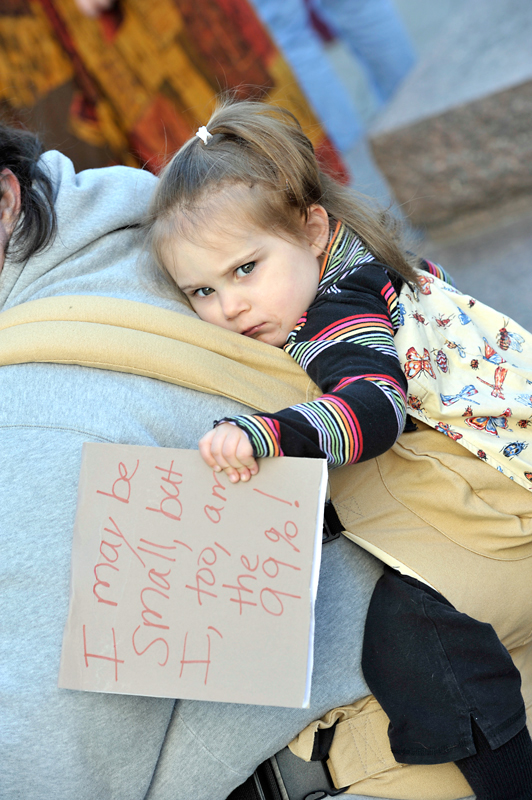
Maren Fletcher, 2, carries her own sign for the November 5th march.

Steve Howard in Piatt Park listens to speakers at the general assembly after the Downtown march.

On November 15, 2011 Occupy Cincinnati protesters chose to defy curfew at Piatt Park again in a solidarity action with Occupy Wall Street due to the recent actions in NYC to close down that occupatiown. Civil Rights Activist Jesse Jackson came down to Piatt Park to speak to the Occupy Cincinnati protesters before the action later that night.
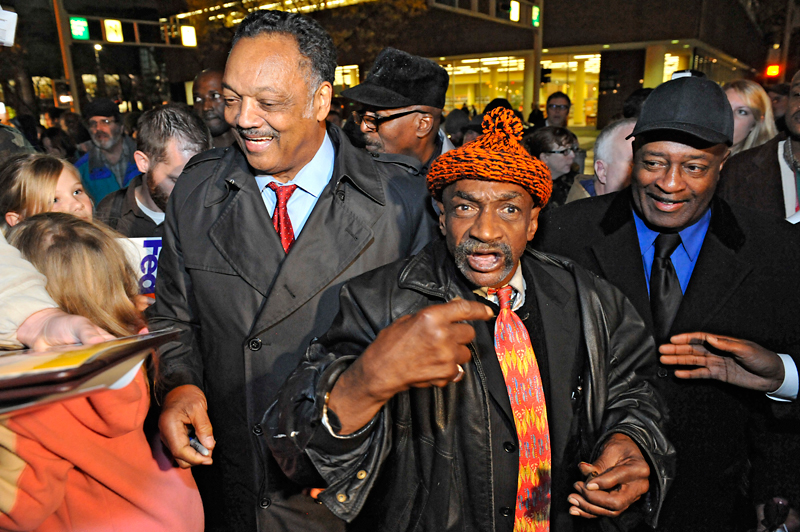
After addressing the Occupation Jesse Jackson greets protesters.

Occupiers discuss issues at the General Assembly before a civil disobedience action to defy the 10pm curfew.

Michael Harris and Dan Berchenko monitor and communicate with social media before the civil disobedience.

Steven Campbell of Clifton flashes peace signs behind the FOX News reporter as she broadcasts live from the park.

Raymond Sherrod and Steven Campbell await the arrival of police at the park.

As police close in to make arrests a black-clad protester confronts their line with two black flags in hand.

Capt. Dan Gerard and other officers give protesters who have linked arms around the statue of President Garfield the option to leave the park or be arrested.

Evie Harris of Middletown is lead away by police.

Evie Harris is questioned by police during her arrest.

A policeman holds plastic handcuffs while making arrests.
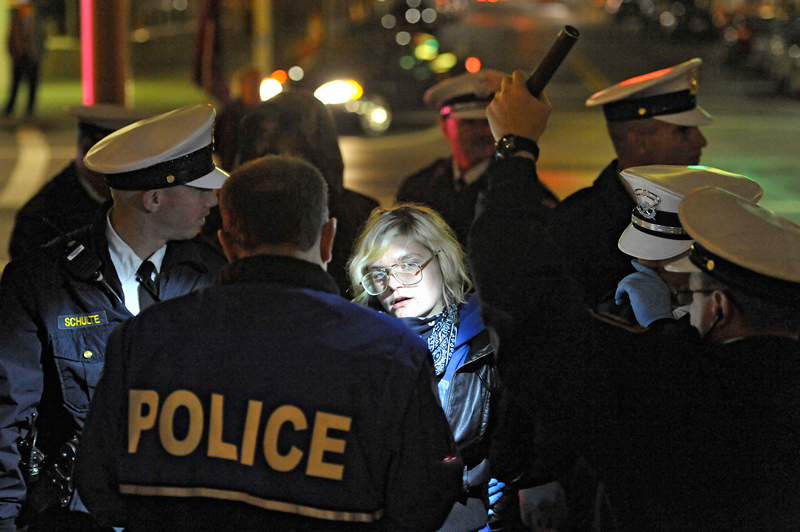
Sophia Schlosser is arrested and processed before being placed on a waiting sheriff's van.

A protester is lit by TV news lights as she is arrested.

Phoenix Richards is taken into custody.

Darius Clay is arrested.

The police systematically remove protesters one by one from the base of the statue. The process was peaceful and orderly. As each protester was arrested the hundred or so protesters on the sidewalks lining both sides of the park chanted the arrestee's name over and over.

Chelsea Sprang is arrested.

Darius Clay is questioned during his arrest.

Chelsea Tunnell chants a call and response to about a hundred supporters that line the sidewalks on each side of the park as she is taken into custody.

James Brown is arrested.

The sheriff's van prepares to transport the arrestees to lock-up. There were 15 arrests for criminal tresspass and 2 of the protesters were also cited with resisting arrest by the time the night was through.

Police stand around the statue of President Garfield after securing the park awaiting further orders..

Police disperse from the area.
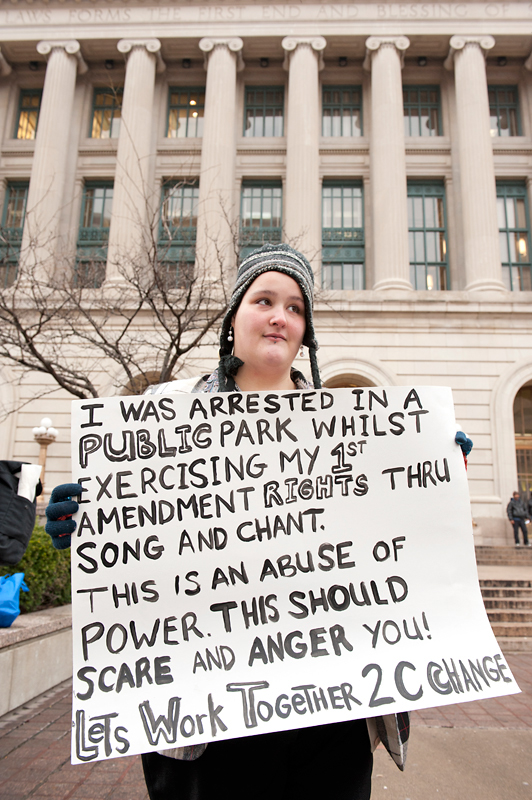
On December 6, 2011, Occupy lawyers began to argue their case in Cincinnati City Court. Chelsea Sprang holds a placard outside the court before the start of the hearing.

Security check at City Court.

Occupy Cincinnati Lawyers Rob Linneman and Jennifer Kinsley speak with Senior Asst. Prosecuting Attorney Melanie Reising before the start of the hearing on December 6, 2011.
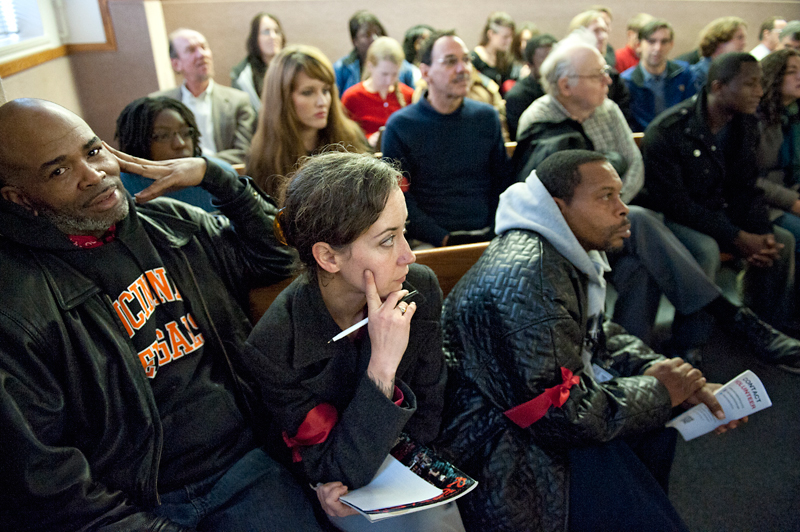
Ocuppy defendants and supporters filled the courtroom on December 6, 2011 as their lawyers argued for dismissal of citation and arrest charges.

Judge Dwane Mallory listens to arguments from defense and city prosecutors.

Occupy Lawyer Geoffrey Miller was on hand for consultation but took a passive role to the defense team of Jennifer Kinsley and Rob Linneman during the hearing.

Capt. Doug Weisman, who supervised police enforcement thoughtout much of the Piatt Park occupation, listens in court as he awaits his turn to give testimony on the case.

Occupy lawyer Jennifer Kinsley makes a point during the December 6th hearing. Defendant Rigel Behrens (center left) sits with the defense team acting as legal liaison for Occupy Cincinnati.

The city solicitors Ryan Taylor and Paula Boggs Muething confer during the hearing.

Occupy lawyer Rob Linneman addresses the court on December 6th.

Asst. City Solicitor Paula Boggs Muething makes the case for the prosecution to Judge Dwane Mallory.

Occupy lawyers Jennifer Kinsley and Rob Linneman confer with each other as the city prosecutors make their case.

Occupy Cincinnati defendant Aaron Roco waits in a clerical office at City Court on the morning of December 7th to take care of paperwork needed for the case at the start of day two of the hearing.

The City of Cincinnati Law Department Chief Supervising Attorney Richard Ganulin makes the city's case to Judge Mallory.

Occupy lawyer Jennifer Kinsley makes counterpoints to the city's case.

Occupy lawyers Jennifer Kinsley and Rob Linneman confer with each other as the city prosecutors make their case.

Occupy lawyer Rob Linneman discusses the case with City Chief Supervising Attorney Richard Ganulin in the hallway durning a recess.

After two days of hearings, testimony and back room negotiations the legal team of Rob Linneman and Jennifer Kinsley bring a possible settlement offer to the defendants. The defendants were not quite ready to accept the settlement offered at this time.

Occupy Lawyers Jennifer Kinsley and Rob Linneman emerge from the judge's chambers after taking the defendants' refusal of settlement to the city prosecutors. The case was adjourned later that day and further negations continued out of court for the next three months.

On March 12, 2012 Occupy Cincinnati held a press conference at City Hall to announce their settlement agreement with the City of Cincinnati over arrests and usage of Piatt Park during Occupy protests the previous Fall. Councilman Cecil Thomas comments on the settlement as Kate Gallion stands by. The settlement agreed to drop citations and criminal tresspass charges against Occupy protesters and established a 24/7 "free speech zone" at the Vine Street entrance to the park that would go into effect March 19th.

Aaron Roco speaks with the press about the settlement as supporter look on.

James Brown was one of the protesters who was cited and arrested multiple times during the previous year's protests.

After the press conference at City Hall a pleased Aaron Roco poses next one of the new signs designating the 24/7 free speech zone in Piatt Park.

The following Monday, March 19th, marked the first official day of the new free speech zone. Josh Spring of the Cincinnati Coalition for the Homeless talks with Harriet Matthey during a General Assembly. This was the first night anyone was legally permitted to remain in a part of the city maintained park after 10pm.

Jim Prues speaks his mind at the general assembly March 19th, 2012.

Greg Zoller of Clifton entertains with a song from the statue steps.

On a beautiful and balmy March 19th night James Thorpe exercises his newly granted right to occupy the tip of the park and express his freedom of speech all night long.
EPILOGUE



